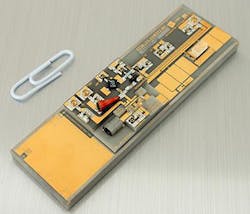DFB laser module designed to test subtleties of General Relativity
Researchers at Ferdinand-Braun-Institut, Leibniz-Institut für Höch-stfrequenztechnik (FBH; Berlin, Germany) have designed and constructed a microintegrated semiconductor-laser module that is park of an atomic clock specifically designed to test the subtleties of Einstein's General Relativity theory. The integration of the laser system took place at Humboldt-Universität zu Berlin (HU Berlin).
General Relativity predicts that clocks run slower the deeper they are in the gravitational potential well of a mass (Gravitational red shift)—a prediction validated many times with high precision. General Relativity also predicts that the rates of all clocks are equally influenced by gravitation independent of how these clocks are physically or technically constructed. However, more recent theories of gravitation allow for the possibility that the type of clock indeed influences the degree of gravitational red shift.
For the rocket experiments, called project FOKUS and funded by the German Aerospace Centre (DLR), the FBH atomic clock and other different types of clocks will be sent via research rocket into space; the change in gravitational strength experienced by the rocket will allow testing whether the type of clock influences the time measurements. The result will help determine whether one of the newer theories of gravity provides a more exact description than Einstein did.
First launch
The first experiments in space have now been successfully carried out: scientists launched an extremely stable quartz oscillator, controlled by the FBH semiconductor-laser module, into space. The frequency of the semiconductor laser was stabilized by locking it to a specific electron transition of a rubidium atom in a module developed at Universität Hamburg, which allows the formation of a separate optical atomic clock that "ticks" about ten million times faster than the quartz unit. To compare how the two clocks run, the company leading the project, Menlo Systems, is using an optical frequency comb it developed.
The scientists demonstrated with the tests that these types of clocks and the laser systems required for them can be used in space for testing gravitational red shift and other precision measurements. Tests of General Relativity will ensue.
Many drop-tower experiments at the Center of Applied Space Technology and Micro-gravity (ZARM), University of Bremen were used to prepare for the experiment in space. The laser module was built at FBH together with the Optical Metrology research group at HU Berlin. The laser itself is a narrow-linewidth distributed feedback (DFB) laser.
Via hybrid microintegration, the laser-diode chip is assembled with electronic and optical components in a compact space-certified package that can easily handle the 8 G rocket liftoff forces, as the package is certified to 30 G.
Source: https://www.fbh-berlin.de/fileadmin/downloads/Press/2015/PM_FBH_FOKUS_Weltraum_2015-04-23_EN.pdf

John Wallace | Senior Technical Editor (1998-2022)
John Wallace was with Laser Focus World for nearly 25 years, retiring in late June 2022. He obtained a bachelor's degree in mechanical engineering and physics at Rutgers University and a master's in optical engineering at the University of Rochester. Before becoming an editor, John worked as an engineer at RCA, Exxon, Eastman Kodak, and GCA Corporation.
